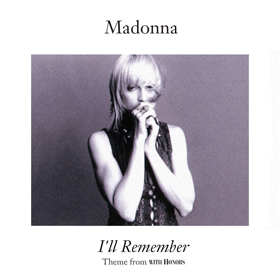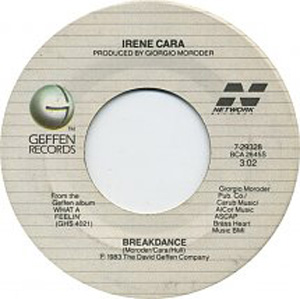
Irene Cara Escalera was an American singer and actress who rose to prominence for her role as Coco Hernandez in the 1980 musical film Fame, and for recording the film's title song "Fame", which reached No. 1 in several countries. In 1983, Cara co-wrote and sang the song "Flashdance... What a Feeling", for which she shared an Academy Award for Best Original Song and won a Grammy Award for Best Female Pop Vocal Performance in 1984.

"Fame" is a song written by Michael Gore (music) and Dean Pitchford (lyrics) and released in 1980, that achieved chart success as the theme song to the Fame film and TV series. The song was performed by Irene Cara, who played the role of Coco Hernandez in the original film. It was also her debut single as a recording artist. The song won the Academy Award for Best Original Song in 1980, and the Golden Globe Award the same year. In 2004, it finished at number 51 on AFI's 100 Years...100 Songs survey of top tunes in American cinema.

"Reach Out I'll Be There" (also formatted as "Reach Out (I'll Be There)") is a song recorded by American vocal quartet Four Tops from their fourth studio album, Reach Out (1967). Written and produced by Motown's main production team, Holland–Dozier–Holland, the song is one of the most widely-known Motown hits of the 1960s and is today considered the Four Tops' signature song.

"Time After Time" is a 1983 song by American singer-songwriter Cyndi Lauper, co-written with Rob Hyman, who also provided backing vocals. It was the second single released from her debut studio album, She's So Unusual (1983). The track was produced by Rick Chertoff and released as a single in March 1984. The song became Lauper's first number 1 hit in the U.S. The song was written in the album's final stages, after "Girls Just Wanna Have Fun", "She Bop" and "All Through the Night" had been written or recorded. The writing began with the title, which Lauper had seen in TV Guide magazine, referring to the science fiction film Time After Time (1979).

"I'll Make Love to You" is a song by American R&B group Boyz II Men for the Motown label. Written by Babyface, it was released in July 1994 as the lead single from their second album, II (1994). The song was a commercial success, spending 14 weeks atop the US Billboard Hot 100. It was also the third best performing song in the 1990s on Billboard, as well as ranking on Billboard Greatest of All-Time chart. "I'll Make Love to You" won the Grammy Award for Best R&B Performance by a Duo or Group with Vocals and was nominated for Record of the Year. Its accompanying music video was directed by Lionel C. Martin.

"Flashdance... What a Feeling" is a song from the 1983 film Flashdance with music by Giorgio Moroder and lyrics by Keith Forsey and the song's performer, Irene Cara. Moroder had been asked to score the film, and Cara and Forsey wrote most of the lyrics after they were shown the last scene from it in which the main character dances at an audition for a group of judges. They felt that the dancer's ambition to succeed could act as a metaphor for achieving any dream a person has and wrote lyrics that described what it feels like when music inspires someone to dance. The song wound up being used for the scene they watched as well as during the opening credits as the main character is shown working as a welder.

"I'll Remember" is a song by American singer Madonna for the 1994 film With Honors. It was released by Maverick and Warner Bros. Records on March 8, 1994, as the lead single from the film's soundtrack album. It was a radical change in image and style for Madonna, who had received huge backlash due to the release of her book Sex, the studio album Erotica and the film Body of Evidence. Warner Bros. decided to release the song for the film after noting most of her previous soundtrack singles had achieved commercial success. It utilizes a synthesized keyboard arrangement to bring about a continuously reverberating heartbeat sound. Madonna's voice is supported by backing vocals.

"How Am I Supposed to Live Without You" is a song co-written in 1982 by Doug James and Michael Bolton. The track was originally recorded by Laura Branigan in 1983, charting at number one in both the US and Canadian Adult Contemporary charts. Bolton later recorded his own version of the song that topped the US Billboard Hot 100 and became a worldwide hit.

"I'll Be There for You" is a song by American rock band Bon Jovi, released as the third single from their 1988 album, New Jersey. The power ballad was written by Jon Bon Jovi and Richie Sambora. The single reached number one on the US Billboard Hot 100 and number five on the Album Rock Tracks chart.

Come On Over is the seventh studio album by British-Australian singer Olivia Newton-John, released in March 1976. The album peaked at number two on the US Top Country Albums chart and number 13 on the US Billboard 200.

"Show Me Heaven" is a song written by American singer and songwriter Maria McKee, Eric Rackin and Jay Rifkin, and recorded by McKee for the soundtrack to the Tom Cruise film Days of Thunder, released in June 1990. Produced by Peter Asher, the power ballad received favorable reviews from most music critics, reached number one on the UK Singles Chart for four weeks and became the sixth-highest-selling single of 1990 in the UK. Additionally, the song became a worldwide hit, topping the charts of Belgium, the Netherlands, and Norway and becoming a top-five hit in Australia, Ireland, Sweden, and Switzerland. It has since been covered by numerous other artists, including Tina Arena.

Carasmatic is Irene Cara's third and final studio album released in 1987. It was her only album for Elektra Records. The album was mostly produced by George Duke. Many popular musicians also contributed to this album such as Luther Vandross, Lynn Davis, James Ingram, Patrice Rushen, Bonnie Raitt, Carole King, John Farrar and Michael Bolton. The album, however, sold poorly and failed to make an impression on the charts.

What a Feelin' is the second studio album by American singer-songwriter Irene Cara. Released on November 2, 1983, this album is a continuation of the work that Cara began with producer Giorgio Moroder on the soundtrack to the 1983 film Flashdance. The dance-pop song she co-wrote with Moroder and Keith Forsey for the film, "Flashdance... What a Feeling", went to number one on Billboard magazine's Hot 100 and foreshadowed the style of this album, which was unlike her R&B-heavy debut. Although Cara was more accustomed to composing music, she relinquished most of those duties to Moroder here and shifted much of her songwriting focus to lyrics.

Flashdance: Original Soundtrack from the Motion Picture is the soundtrack to the 1983 film Flashdance, which tells the story of Alex Owens, a welder and exotic dancer who dreams of becoming a professional ballerina. The nightclub performances by Alex and her co-workers and other set pieces involving training and auditioning provided opportunities to present the songs that would make up the soundtrack album. The film's music supervisor, Phil Ramone, made selections that he felt were the best fit for their respective scenes, and composer Giorgio Moroder contributed additional tracks in the process of scoring the film. One of his contributions, "Flashdance...What a Feeling" by Irene Cara, was released as a single in March 1983, weeks before the film's April 15 release, and eventually spent six weeks at number one on the Billboard Hot 100. The soundtrack was released on April 11, 1983 by Casablanca Records.

"I'll Have to Say I Love You in a Song" is the title of a posthumously released single by the American singer-songwriter Jim Croce. The song was written by Croce and was originally released on his album I Got a Name.

"Dance into the Light" is a song performed by English drummer, singer-songwriter, record producer, and actor Phil Collins, released in September 1996 by Atlantic, Virgin and WEA as the first single from his sixth studio album, Dance into the Light (1996). The song was written by Collins, who also co-produced it with Hugh Padgham. It peaked at number nine on the UK Singles Chart, but was a disappointment on the US Billboard Hot 100 and Cash Box Top 100, reaching number 45 on both charts. The song also peaked within the top 10 in Czech Republic, Hungary and Scotland, while reaching number 29 on the Eurochart Hot 100 in October 1996. The accompanying music video was directed by English musician and music video director Kevin Godley. The track was the only song from Dance into the Light to be featured on his compilation album ...Hits in 1998. B-sides were songs "Take Me Down" and "It's Over".
"Out Here on My Own" is a ballad from the 1980 musical film Fame, performed by Irene Cara. It was written by sibling songwriting duo Lesley Gore (lyricist) and Michael Gore (composer). The recording was produced by Michael Gore. Cara performed the song at the 1981 Academy Awards, where it was nominated for Best Original Song. The song was released on the Fame soundtrack, which also contains an instrumental version of the track.

"Why Me?" is a song written by Giorgio Moroder, Keith Forsey, and the song's performer, Irene Cara, that was the first official single to be released from Cara's 1983 album, What a Feelin', making it the follow-up to the songwriting trio's previous project for Cara, "Flashdance... What a Feeling". This new collaboration, however, was described as having more of a hard rock edge and had lyrics that conveyed the difficulties in a relationship.

"Breakdance" is a song written by Giorgio Moroder, Bunny Hull, and the song's performer, Irene Cara. Moroder's obsession with the dance hit "Rockit" by Herbie Hancock fueled his composition of the music, and Cara was inspired by the street performers she saw growing up in the South Bronx to write lyrics about what was then called breakdancing. Released in March 1984, it was the third single that originated on her What a Feelin' LP and her first to make the top ten in the US since the album's title track went to number one almost a year earlier. "Breakdance" also charted in several other countries and had a dance remix that was also well received.

"The Dream (Hold On to Your Dream)" is a song written by Giorgio Moroder, Pete Bellotte, and the song's performer, Irene Cara, for the 1983 film D.C. Cab. Although not included on initial pressings of Cara's What a Feelin' LP, the decision to release the film four months earlier than originally slated prompted an arrangement for her album to be reissued with the song. A slightly different version (more noticeable in the intro) was also included on the film's soundtrack album; an edited version was released on the 7-inch single, and the 12-inch single included a much longer dance remix.



















